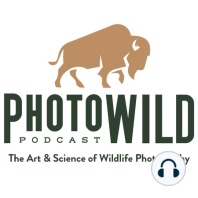60 min listen
Episode 5: Preparing for Yellowstone
ratings:
Length:
56 minutes
Released:
May 3, 2023
Format:
Podcast episode
Description
In episode 5 of the PhotoWILD Podcast, Jared Lloyd and Annalise Kaylor discuss what it takes to plan a trip to Yellowstone National Park in the winter. This year, they spent a month photographing wildlife in this winter wonderland and discuss the many different considerations they make for preparing for their time there. From equipment choices to timing based on statistical averages for weather, if you have ever wanted to photograph in Yellowstone in the winter, you won’t want to miss this episode.
Key Takeaways
While the Greater Yellowstone Ecosystem has the greatest species diversity of mammals in North America, there is an incredible array of avian species to photograph this time of year such as bald eagles, golden eagles, black-billed magpies, snow buntings, and the endangered Rocky Mountain trumpeter swan - to name just a few.
Lens choices are made for very personal reasons based on the exact type of photographs someone wants to create - close up portraits, environment photographs, images of wolves, images of bison, etc. Identifying what the opportunities will be and specifically what type of photographs you want to create of those species should dictate what equipment you bring on a trip like this.
Historically, the Greater Yellowstone Ecosystem experiences very deep cold in January and very snowy conditions in February. If you want frosty bison, you should travel to the region in January. If you want photographs of animals in heavy falling snow, statistically speaking, you should travel to Yellowstone in February.
Low pressure systems impact wildlife behavior. The day before a big storm hits an area, wildlife activity increases exponentially.
Successful wildlife photography often comes down to understanding the very unique windows of time that certain opportunities can be found. For instance, if you want moose in the snow, you should come to Yellowstone as early as possible - December to January 15th. Moose are the first species to loose their antlers in the ecosystem. By the end of January, you will be hard pressed to find a single moose that still holds antlers.
Jared’s Yellowstone kit includes the Nikon 400mm f/2.8 with built in 1.4 TC, the Nikon 800mm PF f/6.3 lens, 2 Nikon Z9 camera bodies, the Sony FX6 cinema camera, and Sony 200-600 f/5.6-6.3 lens.
Annalise’s Yellowstone kit includes the Sony 400mm f/2.8, the Sony 200-600, Sony A1 camera bodies.
Want to join us in Yellowstone next year?
Each year, Jared and Annalise lead workshops to Yellowstone National Park in the winter. If you would like to join us in 2024, which will be Jared’s 31st trip he has led there, then check out https://www.jaredlloyd.com/winter-wildlife-yellowstone
Key Takeaways
While the Greater Yellowstone Ecosystem has the greatest species diversity of mammals in North America, there is an incredible array of avian species to photograph this time of year such as bald eagles, golden eagles, black-billed magpies, snow buntings, and the endangered Rocky Mountain trumpeter swan - to name just a few.
Lens choices are made for very personal reasons based on the exact type of photographs someone wants to create - close up portraits, environment photographs, images of wolves, images of bison, etc. Identifying what the opportunities will be and specifically what type of photographs you want to create of those species should dictate what equipment you bring on a trip like this.
Historically, the Greater Yellowstone Ecosystem experiences very deep cold in January and very snowy conditions in February. If you want frosty bison, you should travel to the region in January. If you want photographs of animals in heavy falling snow, statistically speaking, you should travel to Yellowstone in February.
Low pressure systems impact wildlife behavior. The day before a big storm hits an area, wildlife activity increases exponentially.
Successful wildlife photography often comes down to understanding the very unique windows of time that certain opportunities can be found. For instance, if you want moose in the snow, you should come to Yellowstone as early as possible - December to January 15th. Moose are the first species to loose their antlers in the ecosystem. By the end of January, you will be hard pressed to find a single moose that still holds antlers.
Jared’s Yellowstone kit includes the Nikon 400mm f/2.8 with built in 1.4 TC, the Nikon 800mm PF f/6.3 lens, 2 Nikon Z9 camera bodies, the Sony FX6 cinema camera, and Sony 200-600 f/5.6-6.3 lens.
Annalise’s Yellowstone kit includes the Sony 400mm f/2.8, the Sony 200-600, Sony A1 camera bodies.
Want to join us in Yellowstone next year?
Each year, Jared and Annalise lead workshops to Yellowstone National Park in the winter. If you would like to join us in 2024, which will be Jared’s 31st trip he has led there, then check out https://www.jaredlloyd.com/winter-wildlife-yellowstone
Released:
May 3, 2023
Format:
Podcast episode
Titles in the series (21)
Episode 4: Photographing Pelagic Seabirds in Panama: In this episode, Jared and Annalise discuss photographing pelagic seabirds at a nesting colony along the Caribbean Coast of Panama. While many different species utilize the island, the red-billed tropicbirds and brown boobies stole the show. The word... by The PhotoWILD Podcast
